Digital Twins in the Automotive Industry: The Road toward Physical-Digital Convergence
Abstract
:1. Introduction
1.1. Definition of a Digital Twin
1.2. The Historical Background of the Digital Twin Technology
- Describe the modus operandi of the Digital Twin.
- List published literature works about Digital Twin category applications, Digital Twin process functions, and Digital Twin application domains.
- Quote cases where Digital Twin technology is already applied in the automotive sector.
- Include suggestions about further applications in this domain such as the vehicle’s meta-life as the tools that support this transition (i.e., IoT, AI, and ML) progress as well.
2. Utilization Fields and Applications
3. Digital Twins in Automotive Industry
A Vehicle’s Meta-Life
4. Conclusions
Author Contributions
Funding
Data Availability Statement
Conflicts of Interest
References
- Stark, R.; Fresemann, C.; Lindow, K. Development and operation of Digital Twins for technical systems and services. CIRP Ann. 2019, 68, 129–132. [Google Scholar] [CrossRef]
- Schleich, B.; Anwer, N.; Mathieu, L.; Wartzack, S. Shaping the digital twin for design and production engineering. CIRP Ann. 2017, 66, 141–144. [Google Scholar] [CrossRef] [Green Version]
- Mukherjee, T.; DebRoy, T. A digital twin for rapid qualification of 3D printed metallic components. Appl. Mater. Today 2019, 14, 59–65. [Google Scholar] [CrossRef]
- Qi, Q.; Tao, F.; Zuo, F.; Zhao, D. Digital Twin Service towards Smart Manufacturing. Procedia CIRP 2017, 72, 237–242. [Google Scholar] [CrossRef]
- Botín-Sanabria, D.M.; Mihaita, A.-S.; Peimbert-García, R.E.; Ramírez-Moreno, M.A.; Ramírez-Mendoza, R.A.; Lozoya-Santos, J.d.J. Digital Twin Technology Challenges and Applications: A Comprehensive Review. Remote Sens. 2022, 14, 1335. [Google Scholar] [CrossRef]
- Qian, C.; Liu, X.; Ripley, C.; Qian, M.; Liang, F.; Yu, W. Digital Twin—Cyber Replica of Physical Things: Architecture, Applications and Future Research Directions. Future Internet 2022, 14, 64. [Google Scholar] [CrossRef]
- Anshari, M.; Almunawar, M.N.; Masri, M. Digital Twin: Financial Technology’s Next Frontier of Robo-Advisor. J. Risk Financ. Manag. 2022, 15, 163. [Google Scholar] [CrossRef]
- Martínez-Olvera, C. Towards the Development of a Digital Twin for a Sustainable Mass Customization 4.0 Environment: A Literature Review of Relevant Concepts. Automation 2022, 3, 197–222. [Google Scholar] [CrossRef]
- Grieves, M.; Vickers, J. Origins of the Digital Twin Concept. Working Paper. Florida Institute of Technology/NASA. 2016. Available online: https://www.researchgate.net/publication/307509727_Origins_of_the_Digital_Twin_Concept?channel=doi&linkId=57c6f44008ae9d64047e92b4&showFulltext=true (accessed on 5 April 2022).
- Grieves, M.; Vickers, J. Digital Twin: Mitigating Unpredictable, Undesirable Emergent Behavior in Complex Systems. In Transdisciplinary Perspectives on Complex Systems. New Findings and Approaches; Kahlen, F.-J., Flumerfelt, S., Alves, A., Eds.; Springer International Publishing: Cham, Switzerland, 2017; pp. 85–114. ISBN 978-3-319-38754-3. [Google Scholar]
- The History and Creation of the Digital Twin Concept. Available online: https://www.challenge.org/insights/digital-twin-history/ (accessed on 5 April 2022).
- Mattila, J.; Ala-Laurinaho, R.; Autiosalo, J.; Salminen, P.; Tammi, K. Using Digital Twin Documents to Control a Smart Factory: Simulation Approach with ROS, Gazebo, and Twinbase. Machines 2022, 10, 225. [Google Scholar] [CrossRef]
- Vodyaho, A.I.; Zhukova, N.A.; Shichkina, Y.A.; Anaam, F.; Abbas, S. About One Approach to Using Dynamic Models to Build Digital Twins. Designs 2022, 6, 25. [Google Scholar] [CrossRef]
- Vavrík, V.; Fusko, M.; Bučková, M.; Gašo, M.; Furmannová, B.; Štaffenová, K. Designing of Machine Backups in Reconfigurable Manufacturing Systems. Appl. Sci. 2022, 12, 2338. [Google Scholar] [CrossRef]
- Loaiza, J.H.; Cloutier, R.J. Analyzing the Implementation of a Digital Twin Manufacturing System: Using a Systems Thinking Approach. Systems 2022, 10, 22. [Google Scholar] [CrossRef]
- Benzon, H.-H.; Chen, X.; Belcher, L.; Castro, O.; Branner, K.; Smit, J. An Operational Image-Based Digital Twin for Large-Scale Structures. Appl. Sci. 2022, 12, 3216. [Google Scholar] [CrossRef]
- Coito, T.; Faria, P.; Martins, M.S.E.; Firme, B.; Vieira, S.M.; Figueiredo, J.; Sousa, J.M.C. Digital Twin of a Flexible Manufacturing System for Solutions Preparation. Automation 2022, 3, 153–175. [Google Scholar] [CrossRef]
- Kantaros, A.; Giannatsis, J.; Karalekas, D. A novel strategy for the incorporation of optical sensors in Fused Deposition Modeling parts. In Proceedings of the International Conference on Advanced Manufacturing Engineering and Technologies, Stockolm, Sweden, 27–30 October 2013; Universitets Service US AB, KTH Royal Institite of Technology: Stockholm, Sweden, 2013. ISBN 978-91-7501-893-5. [Google Scholar]
- Kantaros, A.; Karalekas, D. FBG Based In Situ Characterization of Residual Strains in FDM Process. In Residual Stress, Thermomechanics & Infrared Imaging, Hybrid Techniques and Inverse Problems; Conference Proceedings of the Society for Experimental Mechanics Series; Springer: Cham, Switzerland, 2014; Volume 8. [Google Scholar] [CrossRef]
- Kantaros, A.; Karalekas, D. Fiber Bragg Grating Based Investigation of Residual Strains in ABS Parts Fabricated by Fused Deposition Modeling. Process. Mater. Des. 2013, 50, 44–50. [Google Scholar] [CrossRef]
- Kantaros, A.; Piromalis, D.; Tsaramirsis, G.; Papageorgas, P.; Tamimi, H. 3D Printing and Implementation of Digital Twins: Current Trends and Limitations. Appl. Syst. Innov. 2022, 5, 7. [Google Scholar] [CrossRef]
- Yu, J.; Song, Y.; Tang, D.; Dai, J. A Digital Twin approach based on nonparametric Bayesian network for complex system health monitoring. J. Manuf. Syst. 2021, 58, 293–304. [Google Scholar] [CrossRef]
- Yu, J.; Tang, D. Chapter 8—Digital twin-driven prognostics and health management. In Digital Twin Driven Service; Academic Press: Cambridge, MA, USA, 2022; pp. 205–250. ISBN 9780323913003. [Google Scholar] [CrossRef]
- Nguyen, T.J.; Ponciroli, R.; Bruck, P.; Esselman, T.C.; Rigatti, J.A.; Vilim, R.B. A digital twin approach to system-level fault detection and diagnosis for improved equipment health monitoring. Ann. Nucl. Energy 2020, 170, 109002. [Google Scholar] [CrossRef]
- Kamel Boulos, M.N.; Zhang, P. Digital Twins: From Personalised Medicine to Precision Public Health. J. Pers. Med. 2021, 11, 745. [Google Scholar] [CrossRef]
- Corral-Acero, J.; Margara, F.; Marciniak, M.; Rodero, C.; Loncaric, F.; Feng, Y.; Gilbert, Y.; Fernandes, J.F.; Bukhari, H.A.; Wajdan, A.; et al. The ‘Digital Twin’ to enable the vision of precision cardiology. Eur. Heart J. 2020, 41, 4556–4564. [Google Scholar] [CrossRef]
- Chakshu, N.K.; Carson, J.; Sazonov, I.; Nithiarasu, P. A semi-active human digital twin model for detecting severity of carotid stenoses from head vibration—A coupled computational mechanics and computer vision method. Int. J. Numer. Meth Biomed. Engng. 2019, 35, e3180. [Google Scholar] [CrossRef] [PubMed] [Green Version]
- Magosi, Z.F.; Wellershaus, C.; Tihanyi, V.R.; Luley, P.; Eichberger, A. Evaluation Methodology for Physical Radar Perception Sensor Models Based on On-Road Measurements for the Testing and Validation of Automated Driving. Energies 2022, 15, 2545. [Google Scholar] [CrossRef]
- Yang, J.; Son, Y.H.; Lee, D.; Noh, S.D. Digital Twin-Based Integrated Assessment of Flexible and Reconfigurable Automotive Part Production Lines. Machines 2022, 10, 75. [Google Scholar] [CrossRef]
- Ibrahim, M.; Rassõlkin, A.; Vaimann, T.; Kallaste, A. Overview on Digital Twin for Autonomous Electrical Vehicles Propulsion Drive System. Sustainability 2022, 14, 601. [Google Scholar] [CrossRef]
- Tihanyi, V.; Rövid, A.; Remeli, V.; Vincze, Z.; Csonthó, M.; Pethő, Z.; Szalai, M.; Varga, B.; Khalil, A.; Szalay, Z. Towards Cooperative Perception Services for ITS: Digital Twin in the Automotive Edge Cloud. Energies 2021, 14, 5930. [Google Scholar] [CrossRef]
- Salem, T.; Dragomir, M. Options for and Challenges of Employing Digital Twins in Construction Management. Appl. Sci. 2022, 12, 2928. [Google Scholar] [CrossRef]
- Abdeen, F.N.; Sepasgozar, S.M.E. City Digital Twin Concepts: A Vision for Community Participation. Environ. Sci. Proc. 2021, 12, 19. [Google Scholar] [CrossRef]
- Allam, Z.; Bibri, S.E.; Jones, D.S.; Chabaud, D.; Moreno, C. Unpacking the ‘15-Minute City’ via 6G, IoT, and Digital Twins: Towards a New Narrative for Increasing Urban Efficiency, Resilience, and Sustainability. Sensors 2022, 22, 1369. [Google Scholar] [CrossRef]
- Lee, A.; Lee, K.-W.; Kim, K.-H.; Shin, S.-W. A Geospatial Platform to Manage Large-Scale Individual Mobility for an Urban Digital Twin Platform. Remote Sens. 2022, 14, 723. [Google Scholar] [CrossRef]
- Howard, D.A.; Ma, Z.; Aaslyng, J.M.; Jørgensen, B.N. Data Architecture for Digital Twin of Commercial Greenhouse Production. In Proceedings of the 2020 RIVF International Conference on Computing and Communication Technologies (RIVF), Ho Chi Minh, Vietnam, 6–7 April 2020; IEEE: New York, NY, USA, 2020. [Google Scholar]
- Weckesser, F.; Beck, M.; Hülsbergen, K.-J.; Peisl, S. A Digital Advisor Twin for Crop Nitrogen Management. Agriculture 2022, 12, 302. [Google Scholar] [CrossRef]
- Nasirahmadi, A.; Hensel, O. Toward the Next Generation of Digitalization in Agriculture Based on Digital Twin Paradigm. Sensors 2022, 22, 498. [Google Scholar] [CrossRef] [PubMed]
- Henrichs, E.; Noack, T.; Pinzon Piedrahita, A.M.; Salem, M.A.; Stolz, J.; Krupitzer, C. Can a Byte Improve Our Bite? An Analysis of Digital Twins in the Food Industry. Sensors 2022, 22, 115. [Google Scholar] [CrossRef] [PubMed]
- Hurst, W.; Mendoza, F.R.; Tekinerdogan, B. Augmented Reality in Precision Farming: Concepts and Applications. Smart Cities 2021, 4, 1454–1468. [Google Scholar] [CrossRef]
- Chaux, J.D.; Sanchez-Londono, D.; Barbieri, G. A Digital Twin Architecture to Optimize Productivity within Controlled Environment Agriculture. Appl. Sci. 2021, 11, 8875. [Google Scholar] [CrossRef]
- Eclipse Hono. Available online: https://projects.eclipse.org/proposals/hono (accessed on 6 April 2022).
- What Is a Digital Twin? Available online: https://www.ibm.com/topics/what-is-a-digital-twin (accessed on 6 April 2022).
- Digital Twin: Transform Your Operations with Data-Driven and Simulation-Based Digital Twin Software. Available online: https://www.ansys.com/products/digital-twin (accessed on 6 April 2022).
- Digital Twin: Transforming How We Make Sense of Data. Available online: https://www.ptc.com/en/industry-insights/digital-twin (accessed on 7 April 2022).
- About the Oracle IoT Digital Twin Implementation. Available online: https://docs.oracle.com/en/cloud/paas/iot-cloud/iotgs/oracle-iot-digital-twin-implementation.html (accessed on 7 April 2022).
- Azure Digital Twins. Available online: https://azure.microsoft.com/en-us/services/digital-twins/#overview (accessed on 7 April 2022).
- Digital Enterprise: Intelligently Linking and Analyzing Data for Fast and Confident Decisions. Available online: https://new.siemens.com/global/en/company/topic-areas/digital-enterprise.html (accessed on 7 April 2022).
- Fang, X.; Li, H.; Tettamanti, T.; Eichberger, A.; Fellendorf, M. Effects of Automated Vehicle Models at the Mixed Traffic Situation on a Motorway Scenario. Energies 2022, 15, 2008. [Google Scholar] [CrossRef]
- Kantaros, A.; Piromalis, D. Employing a Low-Cost Desktop 3D Printer: Challenges, and How to Overcome Them by Tuning Key Process Parameters. Int. J. Mech. Appl. 2021, 10, 11–19. [Google Scholar] [CrossRef]
- Kantaros, A.; Diegel, O. 3D printing technology in musical instrument research: Reviewing the potential. Rapid Prototyp. J. 2018, 24, 1511–1523. [Google Scholar] [CrossRef]
- Kantaros, A.; Piromalis, D. Fabricating Lattice Structures via 3D Printing: The Case of Porous Bio-Engineered Scaffolds. Appl. Mech. 2021, 2, 289–302. [Google Scholar] [CrossRef]
- Kantaros, A.; Diegel, O.; Piromalis, D.; Tsaramirsis, G.; Khadidos, A.O.; Khadidos, A.O.; Qudus Khan, F.; Jan, S. 3D printing: Making an innovative technology widely accessible through makerspaces and outsourced services. Mater. Today Proc. 2022, 49, 2712–2723. [Google Scholar] [CrossRef]
- Kantaros, A.; Laskaris, N.; Piromalis, D.; Ganetsos, T. Manufacturing Zero-Waste COVID-19 Personal Protection Equipment: A Case Study of Utilizing 3D Printing While Employing Waste Material Recycling. Circ. Econ. Sust. 2021, 1, 851–869. [Google Scholar] [CrossRef]
- DebRoy, T.; Zhang, W.; Turner, J.; Babu, S.S. Building digital twins of 3D printing machines. Scr. Mater. 2017, 135, 119–124. [Google Scholar] [CrossRef]
- Schuh, G.; Bergweiler, G.; Chougule, M.V.; Fiedler, F. Effects of Digital Twin Simulation Modelling on a Flexible and Fixtureless Production Concept in Automotive Body Shops. Procedia CIRP 2021, 104, 768–773. [Google Scholar] [CrossRef]
- Rajesh, P.; Manikandan, N.; Ramshankar, C.; Vishwanathan, T.; Sathishkumar, C. Digital Twin of an Automotive Brake Pad for Predictive Maintenance. Procedia Comput. Sci. 2019, 165, 18–24. [Google Scholar] [CrossRef]
- Prisacaru, A.; Guerrero, E.O.; Chimmineni, B.; Gromala, P.J.; Yang, Y.-H.; Han, B.; Zhang, G.Q. Towards virtual twin for electronic packages in automotive applications. Microelectron. Reliab. 2021, 122, 114134. [Google Scholar] [CrossRef]
- Stączek, P.; Pizoń, J.; Danilczuk, W.; Gola, A. A Digital Twin Approach for the Improvement of an Autonomous Mobile Robots (AMR’s) Operating Environment—A Case Study. Sensors 2021, 21, 7830. [Google Scholar] [CrossRef]
- Kaiblinger, A.; Woschank, M. State of the Art and Future Directions of Digital Twins for Production Logistics: A Systematic Literature Review. Appl. Sci. 2022, 12, 669. [Google Scholar] [CrossRef]
- Gerlach, B.; Zarnitz, S.; Nitsche, B.; Straube, F. Digital Supply Chain Twins—Conceptual Clarification, Use Cases and Benefits. Logistics 2021, 5, 86. [Google Scholar] [CrossRef]
- Abideen, A.Z.; Sundram, V.P.K.; Pyeman, J.; Othman, A.K.; Sorooshian, S. Digital Twin Integrated Reinforced Learning in Supply Chain and Logistics. Logistics 2021, 5, 84. [Google Scholar] [CrossRef]
- Han, W.; Xu, J.; Sun, Z.; Liu, B.; Zhang, K.; Zhang, Z.; Mei, X. Digital Twin-Based Automated Guided Vehicle Scheduling: A Solution for Its Charging Problems. Appl. Sci. 2022, 12, 3354. [Google Scholar] [CrossRef]
- Rimal, B.P.; Kong, C.; Poudel, B.; Wang, Y.; Shahi, P. Smart Electric Vehicle Charging in the Era of Internet of Vehicles, Emerging Trends, and Open Issues. Energies 2022, 15, 1908. [Google Scholar] [CrossRef]
- Kälin, U.; Staffa, L.; Grimm, D.E.; Wendt, A. Highly Accurate Pose Estimation as a Reference for Autonomous Vehicles in Near-Range Scenarios. Remote Sens. 2022, 14, 90. [Google Scholar] [CrossRef]
- Zhang, Z.; Zou, Y.; Zhou, T.; Zhang, X.; Xu, Z. Energy Consumption Prediction of Electric Vehicles Based on Digital Twin Technology. World Electr. Veh. J. 2021, 12, 160. [Google Scholar] [CrossRef]
- Butakov, V.A.; Ioannou, P.A. Personalized Driver/Vehicle Lane Change Models for ADAS. IEEE Trans. Veh. Technol. 2015, 64, 4422–4431. [Google Scholar] [CrossRef]
- Orlovska, J.; Wickman, C.; Söderberg, R. Design of a data-driven communication framework as personalized support for users of ADAS. Procedia CIRP 2020, 91, 121–126. [Google Scholar] [CrossRef]
- Damjanovic-Behrendt, V. A Digital Twin-based Privacy Enhancement Mechanism for the Automotive Industry. In Proceedings of the 2018 International Conference on Intelligent Systems (IS), Wrocław, Poland, 17–18 September 2018; pp. 272–279. [Google Scholar]
- Ezhilarasu, C.M.; Skaf, Z.; Jennions, I.K. Understanding the role of a Digital Twin in Integrated Vehicle Health Management (IVHM). In Proceedings of the 2019 IEEE International Conference on Systems, Man and Cybernetics (SMC), Bari, Italy, 6–9 October 2019; pp. 1484–1491. [Google Scholar] [CrossRef] [Green Version]
- Magargle, R.; Johnson, L.; Mandloi, P.; Davoudabadi, P.; Kesarkar, O.; Krishnaswamy, S.; Batteh, J.; Pitchaikani, A. A simulation-based digital twin for model-driven health monitoring and predictive maintenance of an automotive braking system. In Proceedings of the Linköping Electronic Conference Proceedings, Prague, Czech Republic, 15–17 May 2017; Volume 132, pp. 35–46. [Google Scholar]
- Venkatesan, S.; Manickavasagam, K.; Tengenkai, N.; Vijayalakshmi, N. Health monitoring and prognosis of electric vehicle motor using intelligent-digital twin. IET Electr. Power Appl. 2019, 13, 1328–1335. [Google Scholar] [CrossRef]
- Singh, S.; Shehab, E.; Higgins, N.; Fowler, K.; Tomiyama, T.; Fowler, C. Challenges of Digital Twin in High Value Manufacturing; SAE Technical Papers; SAE International: Warrendale, PA, USA, 2018. [Google Scholar] [CrossRef] [Green Version]
- Fuller, A.; Fan, Z.; Day, C.; Barlow, C. Digital twin: Enabling technologies, challenges and open research. IEEE Access 2020, 8, 108952–108971. [Google Scholar] [CrossRef]
- Tsaramirsis, G.; Kantaros, A.; Al-Darraji, I.; Piromalis, D.; Apostolopoulos, C.; Pavlopoulou, A.; Alrammal, M.; Ismail, Z.; Buhari, S.M.; Stojmenovic, M.; et al. A Modern Approach towards an Industry 4.0 Model: From Driving Technologies to Management. J. Sens. 2022, 2022, 5023011. [Google Scholar] [CrossRef]
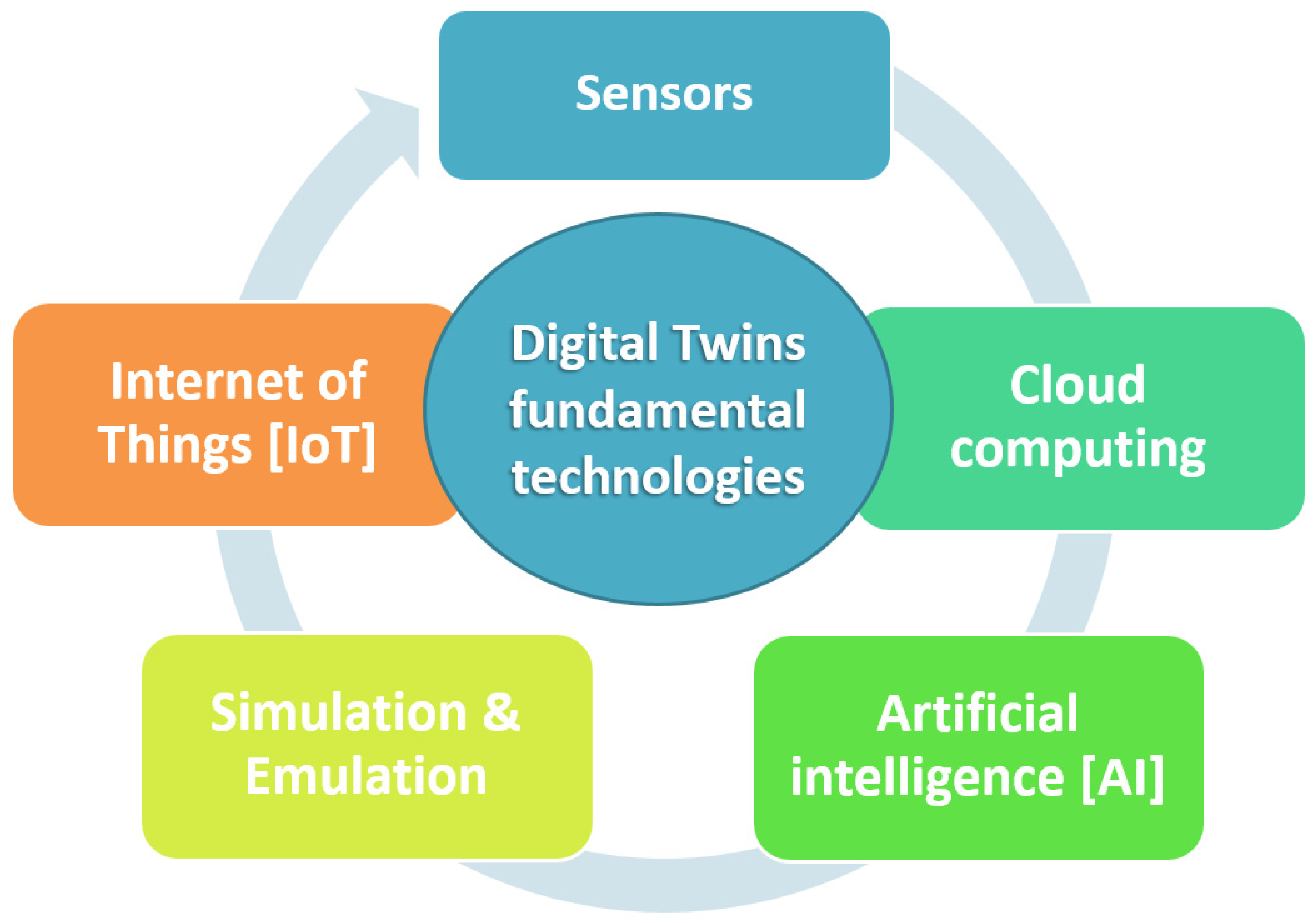
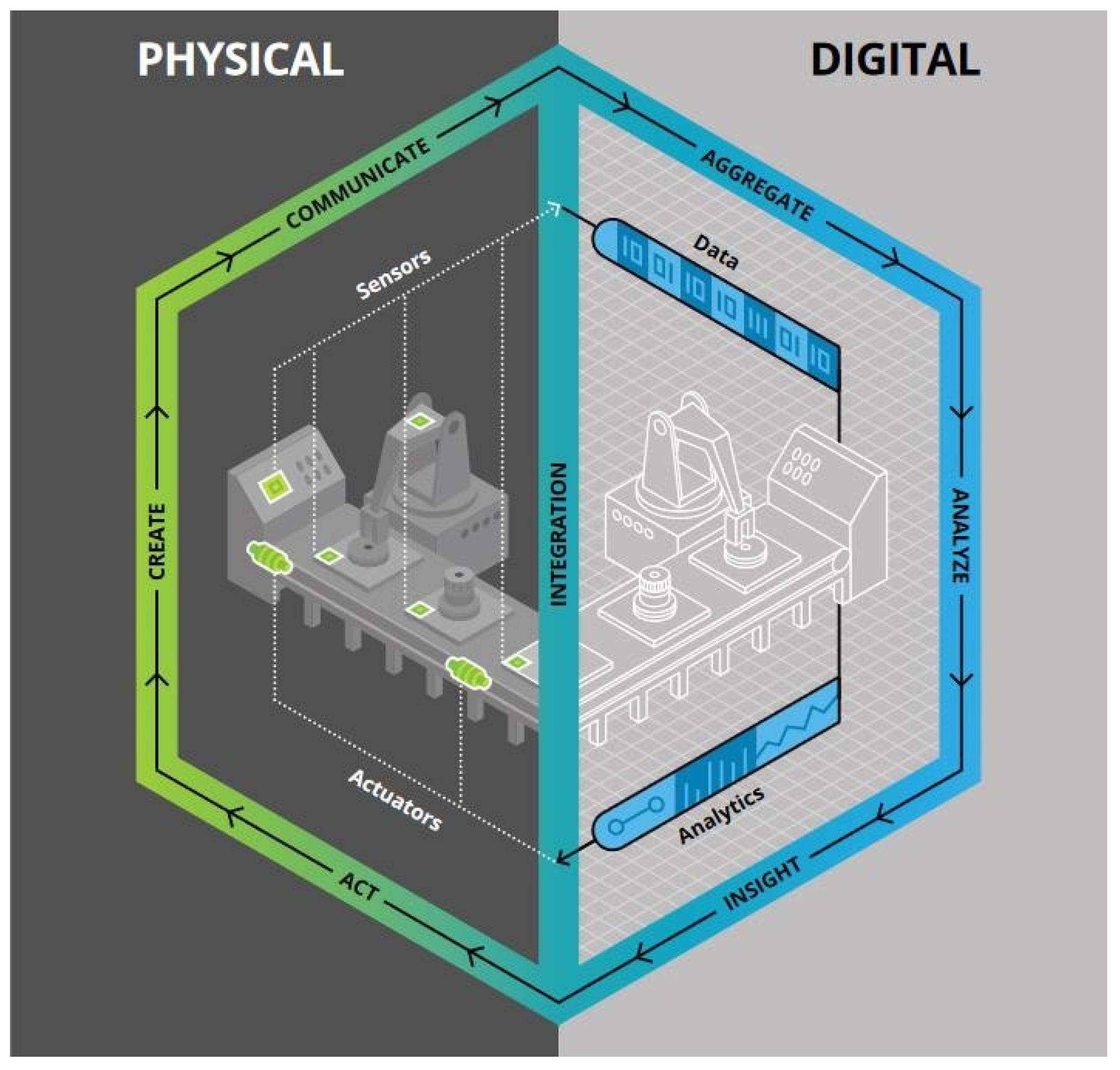
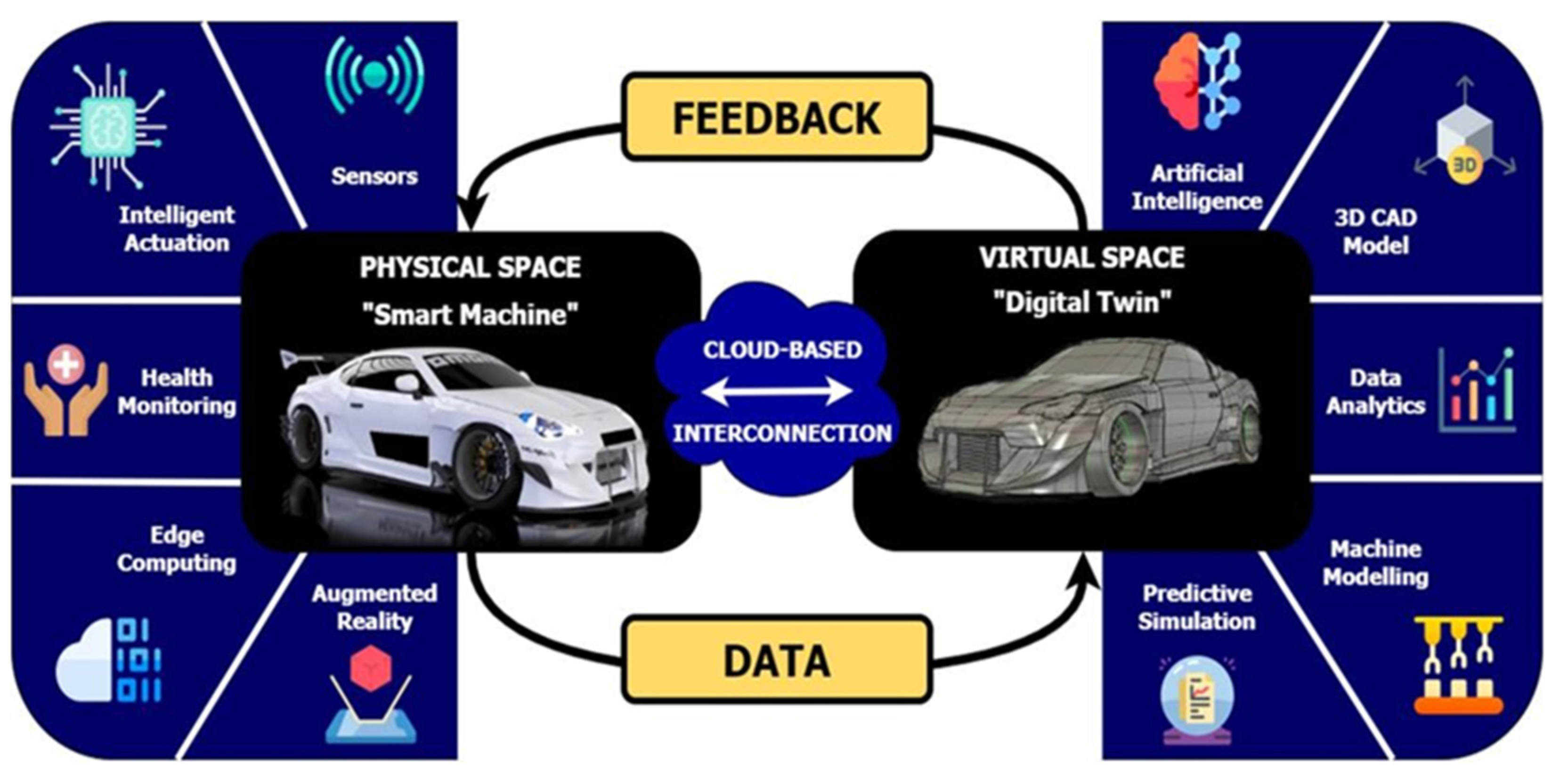
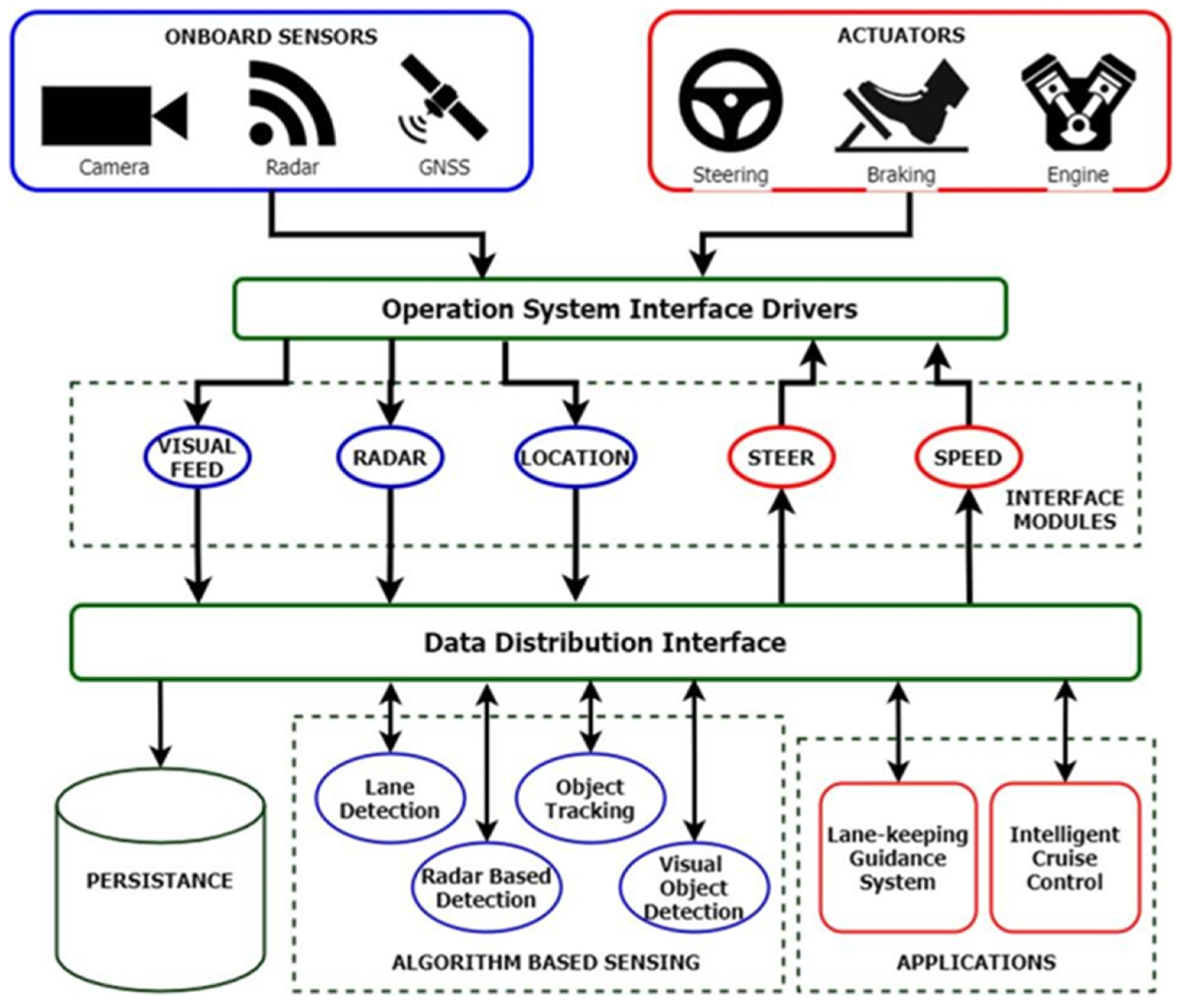
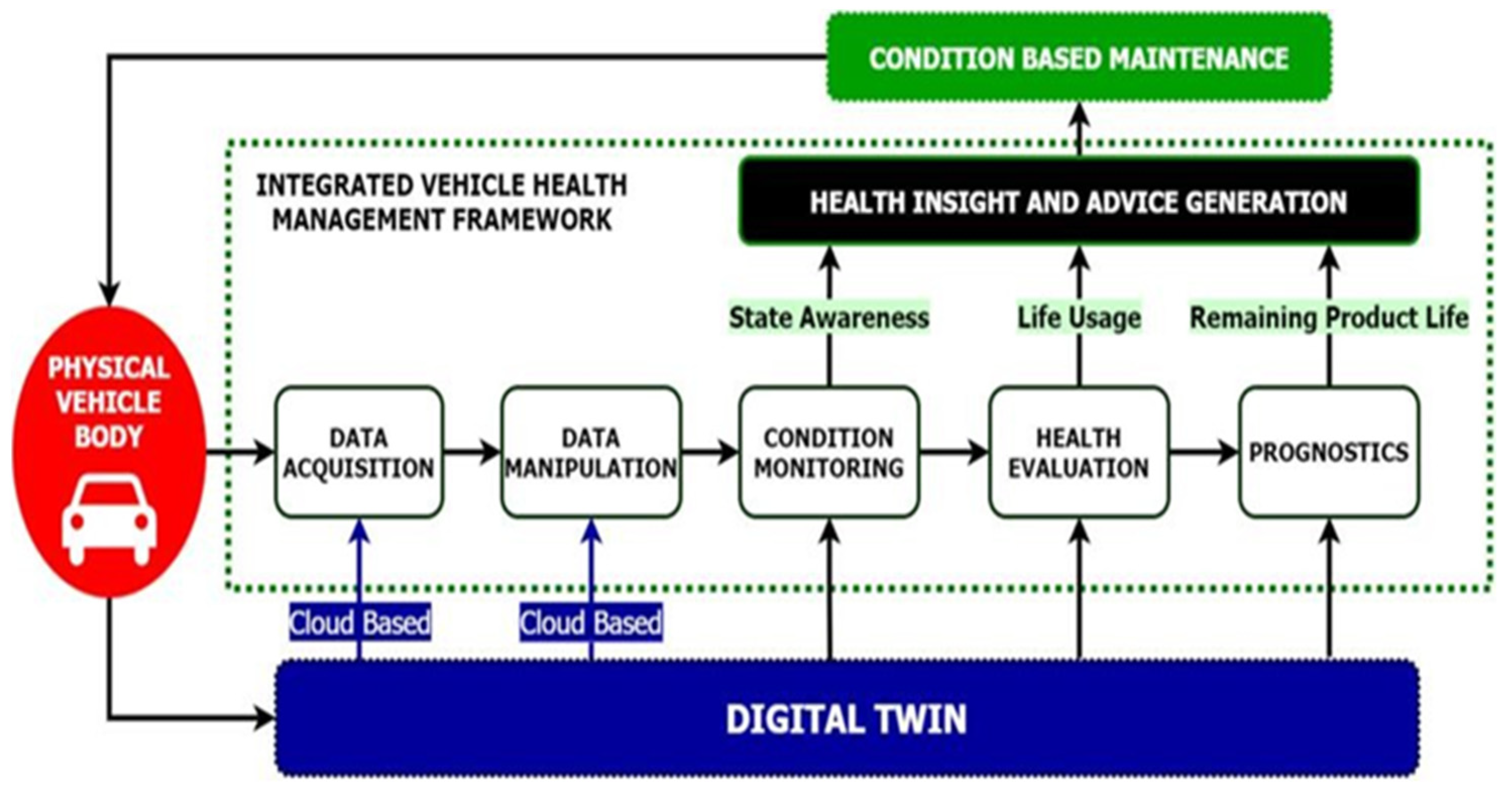
| Digital Twin Category Application | |
|---|---|
| Product Twins | Operators compile a nonphysical prototype of an object before creating the actual production line to investigate how it will function under various scenarios and what potential malfunctions may arise. Thus, all necessary alterations can be made that will lead to an optimized design. |
| Process twins | Virtual and simulated processes can lead to different cases and depict the outcome under varying conditions. In order to develop an optimized production planning, twin products for each piece of equipment involved can be made in this context. |
| System Twins | Virtual systems of real-world integrated systems. They acquire a large number of systemic information generated by systems, obtain information, and create opportunities to optimize processes and the greater system. |
| Digital Twin Process Functions | |
|---|---|
| Design | Visualization processes can be used during design for verification and inspection of the overall 3D design assembly of the product in order to verify that their matching and fitting are the desired ones. |
| Diagnostics | The simulations along with their various sensor readings can analyze some nonaccessible data such as various forces and stresses applied in different parts of the product. |
| Prediction | With engineering and deep learning algorithms, forecasting can be conducted accurately and in a timely manner for the purpose of the longevity of the equipment or unit. In addition, all the information is available in real-time operation and assists in the design of rational maintenance plans for the reduction of potential nonscheduled operation interruptions. |
| Maintenance | A digital twin can analyze performance data collected within a certain time interval and under various conditions. Combined analysis provides the required information for the users, in order to proceed with the appropriate maintenance actions. |
| Digital Twin Application Domains | |
|---|---|
| Industrial production | Facilitates activities such as monitoring, coordination, and control of industrial systems in production lines. Its main function lies in the reduction of errors and production delivery time [12,13,14,15,16,17,18,19,20,21]. |
| Health sector | Revolutionizes the healthcare sector by enhancing clinical procedures and hospital management, with digital monitoring and advanced modeling of systems of the human body. These tools are very helpful to researchers in the study of various diseases, novel drug formulas, and medical devices [22,23,24,25,26,27]. |
| Automotive | Used in the design of new products as well in the production lines. At the same time and after the completion of the product manufacturing, it can measure specific patterns and functional information of the vehicle with the purpose of aiding in its performance increase [28,29,30,31]. |
| Smart cities | Combined with the Internet of Things, it can increase the efficient design of a smart city. This can be achieved by reinforcing its financial indicators, improving its management resources, and reducing the environmental impact of each citizen [32,33,34,35] |
| Agriculture | The monitoring of land assets by installing various tools and sensors, i.e., in water, temperature, and humidity, for crop protection, maximization of profits, and reduction of failures [36,37,38,39,40,41]. |
Publisher’s Note: MDPI stays neutral with regard to jurisdictional claims in published maps and institutional affiliations. |
© 2022 by the authors. Licensee MDPI, Basel, Switzerland. This article is an open access article distributed under the terms and conditions of the Creative Commons Attribution (CC BY) license (https://creativecommons.org/licenses/by/4.0/).
Share and Cite
Piromalis, D.; Kantaros, A. Digital Twins in the Automotive Industry: The Road toward Physical-Digital Convergence. Appl. Syst. Innov. 2022, 5, 65. https://doi.org/10.3390/asi5040065
Piromalis D, Kantaros A. Digital Twins in the Automotive Industry: The Road toward Physical-Digital Convergence. Applied System Innovation. 2022; 5(4):65. https://doi.org/10.3390/asi5040065
Chicago/Turabian StylePiromalis, Dimitrios, and Antreas Kantaros. 2022. "Digital Twins in the Automotive Industry: The Road toward Physical-Digital Convergence" Applied System Innovation 5, no. 4: 65. https://doi.org/10.3390/asi5040065
APA StylePiromalis, D., & Kantaros, A. (2022). Digital Twins in the Automotive Industry: The Road toward Physical-Digital Convergence. Applied System Innovation, 5(4), 65. https://doi.org/10.3390/asi5040065







